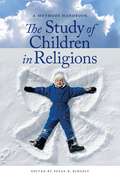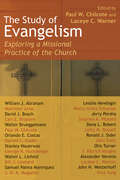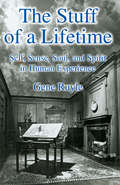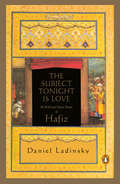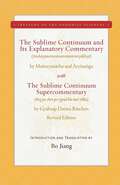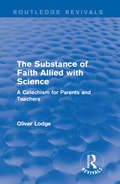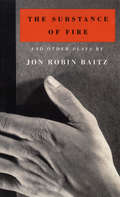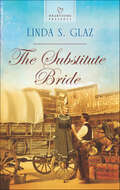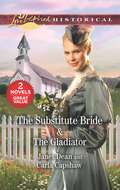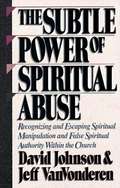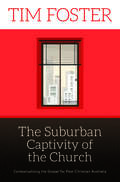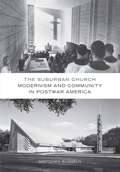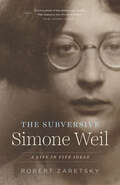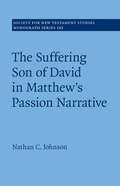- Table View
- List View
The Study of Children in Religions: A Methods Handbook
by Susan B. RidgelyResearch in religious studies has traditionally focused on adult subjects since working with children presents significantly more challenges to the researcher, such as getting the research protocol passed by the Internal Review Board, obtaining permission from parents and schools, and figuring out how to make sense of young worldviews. The Study of Children in Religions provides scholars with a comprehensive source to assist them in addressing many of the issues that often stop researchers from pursuing projects involving children. This handbook offers a broad range of methodological and conceptual models for scholars interested in conducting work with children. It not only illuminates some of the legal and ethical issues involved in working with youth and provides guidance in getting IRB approval, but also presents specific case studies from scholars who have engaged in child-centered research and here offer the fruits of their experience. Cases include those that use interviews and drawings to work with children in contemporary settings, as well as more historically focused endeavors to use material culture—such as Sunday school projects or religious board games—to study children’s religious lives in past eras. The Study of Children in Religions offers concrete help to those who wish to conduct research on children and religion but are unsure of how to get started or how to frame their research.
The Study of Evangelism: Exploring a Missional Practice of the Church
by Laceye C. Warner Paul ChilcoteChristians and communities of faith today are rediscovering evangelism as an essential aspect of the church's mission. Many of the resulting books in the marketplace, however, have a hands-on orientation, often lacking serious theological engagement and reflection. Bucking that how-to trend,The Study of Evangelism offers thirty groundbreaking essays that plumb the depths of the biblical and theological heritage of the church with reference to evangelistic practice. Helpfully organized into six categories, these broad, diverse writings lay a solid scholarly foundation for meaningful dialogue about the church's practice of evangelism.
The Study of Human Nature: A Reader (Second Edition)
by Leslie StevensonThis anthology provides an introduction to a variety of views about human nature, from various cultures over three millennia. It ranges from ancient religious texts down to contemporary theories based on evolutionary science. It can be used as a reader to go along with Ten Theories of Human Nature 4e, but it can also be used independently.
The Study of Liturgy
by Geoffrey Wainwright Cheslyn Jones Paul Bradshaw Edward S. YarnoldCompletely revised to incorporate new scholarship and many important developments in liturgical renewal, this standard text remains an essential tool for students of theology and liturgy. It treats the development of the liturgy historically, beginning with Jewish antecedents, then covering the New Testament, Patristic, Medieval, and Reformation periods, and concluding with the increasing interest in liturgy in all churches today. The text deals definitively with the five central rites of Christian worship: Initiation, the Eucharist, Ordination, the Daily Office, and the Calendar. A special section on liturgical settings examines in detail the historical importance of music and singing in the liturgy and the role of hymnody in Christian worship. Reflecting the continuing trend towards ecumenism, the editors represent the Anglican, Roman Catholic, and Protestant traditions, while the Orthodox tradition is represented by the team of contributors, which includes many of the best-known liturgical scholars.
The Stuff of a Lifetime: Self, Sense, Soul, and Spirit in Human Experience
by Gene RuyleA book to help people understand what they are doing with their lives. Addressing its readers directly and as individuals, this book allows them to move through it in their own way. It takes them on a wide-ranging expedition into their lives, so that they may be better guided by their own uniqueness. It seeks to enkindle within people the desire to reclaim their bodies, recover their souls, and re-enter the world. "A book that should make a name for Gene Ruyle as a contemporary philosopher who has something important to say. " -Atlanta Journal/Constitution (www. generuyle. com)
The Style and Mythology of Socialism: Socialist Idealism, 1871-1914 (Routledge Studies in Modern History)
by Stefan ArvidssonArguably no modern ideology has diffused as fast as Socialism. From the mid-nineteenth century to the last quarter of the twentieth socialist ideals played a crucial part not only in the political sphere, but also influenced the way people worked and played, thought and felt, designed and decorated, hoped and yearned. By proposing general observations on the relationship between socialism, imagination, myth and utopia, as well as bringing the late nineteenth century socialist culture – a culture imbued with Biblical narratives, Christian symbols, classic mythology, rituals from freemasonry, Viking romanticism, and utopian speculations – together under the novel term ‘socialist idealism’, The Style and Mythology of Socialism: Socialist Idealism, 1871–1914 draws attention to the symbolic, artistic and rhetorical ways that socialism originally set the hearts of people on fire.
The Sub-Conscious Speaks
by Erna Ferrell Grabe Paul C. FerrellContacting the Sub-Conscious, or Subjective mind, without loss of conscious identity has long been sought. This feat has here unquestionably been accomplished. The contents of the book proper belong entirely to the author’s Subjective mind. Yet at no time was there a loss of conscious control and direction, nor was the author at any time in any other than a perfectly normal condition.It is not deemed necessary to state the manner in which this contact was established. Suffice it to say that sufficient tests and experiments were made to convince the author and others that they were dealing with the author’s Subjective mind.
The Subject Tonight Is Love: 60 Wild and Sweet Poems of Hafiz (Compass)
by Daniel Ladinsky HafizTo Persians, the fourteenth-century poems of Hafiz are not classical literature from a remote past, but cherished love, wisdom, and humor from a dear and intimate friend. Perhaps, more than any other Persian poet, it is Hafiz who most fully accesses the mystical, healing dimensions of poetry. Daniel Ladinsky has made it his life's work to create modern, inspired translations of the world's most profound spiritual poetry. Through Ladinsky's translations, Hafiz's voice comes alive across the centuries singing his message of love.
The Subject, Capitalism, and Religion
by Jung Mo SungIn order to fight for a more just society, it is necessary to elaborate upon the theoretical reflections that critically analyze the faith and myths that support and legitimize the trajectory of contemporary capitalism and its utopia, as well as the faith and the complex relation that exists in between the notions of the subject and societies.
The Sublime Continuum and Its Explanatory Commentary: With the Sublime Continuum Supercommentary - Revised Edition (Treasury of the Buddhist Sciences)
by Bo JiangExplore an in-depth explanation of buddha nature and self-emptiness.The original Sublime Continuum Explanatory Commentary was written by Noble Asanga to explain the verses received from the bodhisattva Maitreya in the late fourth century CE in northern India. Here it is introduced and presented in an original translation from Sanskrit and Tibetan, with the translation of an extensive Tibetan Supercommentary by Gyaltsap Darma Rinchen (1364–1432), whose work closely followed the view of his teacher, Tsong Khapa (1357–1419). Contemporary scholars have widely misunderstood the Buddhist Centrist (Madhyamaka) teaching of emptiness, or selflessness, as either a form of nihilism or a radical skepticism. Yet Buddhist philosophers from Nagarjuna on have shown that the negation of intrinsic reality, when accurately understood, affirms the supreme value of relative realities. Gyaltsap Darma Rinchen, in his Supercommentary, elucidates a highly positive theory of the buddha nature, showing how the wisdom of emptiness empowers the compassionate life of the enlightened, as it is touched by its oneness with the truth body of all buddhas. With his clear study of Gyaltsap&’s insight and his original English translation, Bo Jiang completes his historic project of studying and presenting these works from Sanskrit and Tibetan in both Chinese and, now, English translations, in linked publications.
The Substance of Faith Allied with Science: A Catechism for Parents and Teachers (Routledge Revivals)
by Oliver LodgeOriginally published in 1907, this book provides information to parents and teachers wishing to teach their children about Christianity as well as science. Lodge details his fear of mandatory secularism in schools and advises how to instruct children in science without allowing any doubt of Christian doctrine and stresses the importance of reconciliation between religion and science for future generations. This title will be of interest to students of Education and Religion.
The Substance of Fire and Other Plays
by Jon Robin BaitzA frank examination of the controlling forces behind a nearly bankrupt private school for boys in South Africa, The Film Society introduced a young playwright with an extraordinarily mature grasp of people, language and society.Baitz's recent works have fulfilled his early promise and enhanced his reputation. <P><P>In The Substance of Fire (1991), a fiercely intellectual New York publisher struggles with his children for control of his business, and with the relentless pride which has made him previous to love. In The End of the Day (1992), an expatriate British doctor adapts to America by abandoning his ideals and succumbing to the twin lures of status and crime.About the Author: Jon Robin Baitz is the author of Three Hotels, The Film Society, Other Desert Cities, The End of the Day, and The Substance of Fire, which he adapted into a major motion picture. He was the showrunner on ABC's Brothers & Sisters. He also wrote the screenplay for the upcoming film Stonewall directed by Roland Emmerich. He lives in New York.
The Substance of Things Seen: Art, Faith, and the Christian Community (Calvin Institute of Christian Worship Liturgical Studies)
by Robin JensenWhile the average person rarely sees it, the visual arts play a subtle yet profound role in the teaching and formation of faith, both for individuals and religious communities. The Substance of Things Seen explores the intersection of art and faith, offering thoughtful reflections on the way art functions in Christian life and practice. <p><p> Highly readable and featuring instructive illustrations, this book is meant to engage church leaders as well as artists in constructive conversation about the critical role that art can play in the renewal of Christian education, worship, and study. It also challenges anyone who thinks the arts are only of marginal importance to the religious life. Robin Jensen considers here a broad range of topics relevant to Christian faith and culture, including the construction of sacred space, the use of art in worship and spiritual formation, the way that visual art interprets sacred texts, and the power and danger of art from a historical and contemporary perspective.
The Substitute Bride
by Janet DeanFleeing an arranged marriage, debutante Elizabeth Manning exchanges places with a mail-order bride bound for New Harmony, Iowa. Life on the frontier can't be worse than forced wedlock to pay her father's gambling debts. But Ted Logan's rustic lifestyle and rambunctious children prove to be more of a challenge than Elizabeth expects. She doesn't know how to be a mother or a wife. She doesn't even know how to tell Ted the truth about her past—especially as her feelings for him grow. Little does she know, Ted's hiding secrets of his own, and when their pasts collide, there's more than one heart at stake.
The Substitute Bride
by Linda S. GlazJared Callahan's mysterious bride Rancher Jared Callahan eagerly awaited the arrival of his mail-order bride. But instead of the kindhearted woman who wrote about escaping her constrained city life, the beauty who arrived in his remote frontier town couldn't remember anything. Not him, not their long-distance courtship, not even her own name. What is he going to do with this petite spitfire? Dazed and confused from a railway accident, Rebecca Layne finds herself saying "I do" to the handsome stranger who claims to be her betrothed. But as feelings for Jared blossom, the mysteries of her past threaten to unravel her life at the seams. Only when the truth is finally revealed can this marriage of convenience ever become a true union of love.
The Substitute Bride & The Gladiator: A 2-in-1 Collection
by Carla Capshaw Janet DeanEnjoy two stories of strength and hope in days gone by from Love Inspired HistoricalThe Substitute Bride by Janet DeanFleeing an arranged marriage, Elizabeth Manning exchanges places with a mail-order bride bound for New Harmony, Iowa. Life on the frontier can’t be worse than forced wedlock to pay her father’s gambling debts. But Ted Logan’s rustic lifestyle and rambunctious children are more of a challenge than Elizabeth expects. And how can she tell Ted the truth about her past? Little does she know, Ted’s hiding secrets of his own…The Gladiator by Carla CapshawShould anyone learn she is a Christian, slave Pelonia Valeria will be executed. Her faith threatens not only herself, but her master, legendary gladiator Caro Viriathos. Can she convince a man who found fame through unforgiving brutality to show mercy? And when she’s ultimately given the choice, will Pelonia choose freedom or the love of a gladiator?
The Substitute Guest (Grace Livingston Hill #20)
by Grace Livingston HillThe Substitute Guest Handsome Alan Monteith is not spending Christmas Eve as he intended. Rather than celebrating at a party with friends, he takes on a life-and-death mission of mercy in the mountains! Then his car breaks down, and, lost and exhausted, he must struggle through a raging blizzard to find help. That is when he encounters the Devereaux family--and the help, acceptance, and love he finds with them touches his heart and changes the path of his life. Grace Livingston Hill is the beloved author of more than 100 books. Her wholesome stories contain adventure, romance, and the heartwarming triumphs of people faced with the problems of life and love. You'll find over 60 books by Grace Livingston Hill in the Bookshare library including #22 Rose Galbraith, #24 By way of the silverthorns, #26 The Seventh Hour, #30 Matched Pearls, #33 Happiness Hill, #36 Patricia, #37 Silver wings, #38 Spice Box, #41 blue ruin, #42 A New Name, #46 Through These Fires, #47 The Street of the City, #50 The Finding of Jasper Holt, #53 Job's Niece, #55 Ladybird, #56 The Prodigal Girl, #57 The Honor Girl and #60 Miranda. with more coming soon.
The Subtle Power of Spiritual Abuse
by David Johnson Jeff VanvonderenThis book examines what spiritual abuse is and how to overcome it.
The Subtleties of the Inimitable Mulla Nasrudin, and the Exploits of the Incomparable Mulla Nasrudin
by Idries ShahThe Mulla and his stories appear in literature and oral traditions from the Middle East to Greece, Russia, France -- even China. Many nations claim Nasrudin as a native son, the Turks going so far as to exhibit a grave with his date of death as 386. But nobody really knows who he was or where he came from. According to a legend dating from at least the 13th century, Nasrudin was snatched as a schoolboy from the clutches of the "Old Villain" -- the crude system of thought that ensnares man -- to carry through the ages the message of how to escape. He was chosen because he could make people laugh, and humor has a way of slipping through the cracks of the most rigid thinking habits. Today -- as they have for centuries -- the Sufis use these stories as teaching exercises, in part to momentarily "freeze" situations in which states of mind can be recognized. In these delightful volumes, Shah not only gives the Mulla a proper vehicle for our times, he proves that the centuries-old stories and quips of Nasrudin are still some of the funniest jokes in the world.
The Suburban Captivity of the Church: Contextualising the Gospel for Post-Christian Australia
by Tim FosterFor far too long, Australian evangelicals have proclaimed a gospel loaded with the cultural baggage of suburbia: personal security, individual salvation and an other-worldly focus. Is this message really a set of timeless truths with universal application? Or have we injected Jesus' message with our own values?The Suburban Captivity of the Church calls us to venture beyond the picket fence and engage with the cultural narratives around us, to see how God's big story meets them with both challenge and hope. Whether we are reaching a new culture, or trying to bring the gospel to our own in a more biblically faithful way, this book will equip us for the task.
The Suburban Church: Modernism and Community in Postwar America (Architecture, Landscape and Amer Culture)
by Gretchen BuggelnAfter World War II, America&’s religious denominations spent billions on church architecture as they spread into the suburbs. In this richly illustrated history of midcentury modern churches in the Midwest, Gretchen Buggeln shows how architects and suburban congregations joined forces to work out a vision of how modernist churches might help reinvigorate Protestant worship and community. The result is a fascinating new perspective on postwar architecture, religion, and society.Drawing on the architectural record, church archives, and oral histories, The Suburban Church focuses on collaborations between architects Edward D. Dart, Edward A. Sövik, Charles E. Stade, and seventy-five congregations. By telling the stories behind their modernist churches, the book describes how the buildings both reflected and shaped developments in postwar religion—its ecumenism, optimism, and liturgical innovation, as well as its fears about staying relevant during a time of vast cultural, social, and demographic change.While many scholars have characterized these congregations as &“country club&” churches, The Suburban Church argues that most were earnest, well-intentioned religious communities caught between the desire to serve God and the demands of a suburban milieu in which serving middle-class families required most of their material and spiritual resources.
The Subversive Evangelical: The Ironic Charisma of an Irreligious Megachurch (Advancing Studies in Religion Series #6)
by Peter J. SchuurmanEvangelicals have been scandalized by their association with Donald Trump, their megachurches summarily dismissed as “religious Walmarts.” In The Subversive Evangelical Peter Schuurman shows how a growing group of “reflexive evangelicals” use irony to critique their own tradition and distinguish themselves from the stereotype of right-wing evangelicalism. Entering the Meeting House – an Ontario-based Anabaptist megachurch – as a participant observer, Schuurman discovers that the marketing is clever and the venue (a rented movie theatre) is attractive to the more than five thousand weekly attendees. But the heart of the church is its charismatic leader, Bruxy Cavey, whose anti-religious teaching and ironic tattoos offer a fresh image for evangelicals. This charisma, Schuurman argues, is not just the power of one individual; it is a dramatic production in which Cavey, his staff, and attendees cooperate, cultivating an identity as an “irreligious” megachurch and providing followers with a more culturally acceptable way to practise their faith in a secular age. Going behind the scenes to small group meetings, church dance parties, and the homes of attendees to investigate what motivates these reflexive evangelicals, Schuurman reveals a playful and provocative counterculture that distances itself from prevailing stereotypes while still embracing a conservative Christian faith.
The Subversive Evangelical: The Ironic Charisma of an Irreligious Megachurch (Advancing Studies in Religion)
by Peter J. SchuurmanEvangelicals have been scandalized by their association with Donald Trump, their megachurches summarily dismissed as “religious Walmarts.” In The Subversive Evangelical Peter Schuurman shows how a growing group of “reflexive evangelicals” use irony to critique their own tradition and distinguish themselves from the stereotype of right-wing evangelicalism. Entering the Meeting House – an Ontario-based Anabaptist megachurch – as a participant observer, Schuurman discovers that the marketing is clever and the venue (a rented movie theatre) is attractive to the more than five thousand weekly attendees. But the heart of the church is its charismatic leader, Bruxy Cavey, whose anti-religious teaching and ironic tattoos offer a fresh image for evangelicals. This charisma, Schuurman argues, is not just the power of one individual; it is a dramatic production in which Cavey, his staff, and attendees cooperate, cultivating an identity as an “irreligious” megachurch and providing followers with a more culturally acceptable way to practise their faith in a secular age. Going behind the scenes to small group meetings, church dance parties, and the homes of attendees to investigate what motivates these reflexive evangelicals, Schuurman reveals a playful and provocative counterculture that distances itself from prevailing stereotypes while still embracing a conservative Christian faith.
The Subversive Simone Weil: A Life in Five Ideas
by Robert ZaretskyThis exploration of the contradictary philosopher is “a beautifully sharp and thoughtful account of her life and work—a fascinating read” (Sarah Bakewell, New York Times–bestselling author).Known as the “patron saint of all outsiders,” Simone Weil (1909–43) was one of the twentieth century's most remarkable thinkers, a philosopher who truly lived by her political and ethical ideals. In a short life framed by the two world wars, Weil taught philosophy to lycée students and organized union workers, fought alongside anarchists during the Spanish Civil War and labored alongside workers on assembly lines, joined the Free French movement in London and died in despair because she was not sent to France to help the Resistance.Though Weil published little during her life, after her death, thanks largely to the efforts of Albert Camus, hundreds of pages of her manuscripts were published to critical and popular acclaim. While many seekers have been attracted to Weil's religious thought, Robert Zaretsky gives us a different Weil, exploring her insights into politics and ethics, and showing us a new side of Weil that balances her contradictions—the rigorous rationalist who also had her own brand of Catholic mysticism; the revolutionary with a soft spot for anarchism yet who believed in the hierarchy of labor; and the humanitarian who emphasized human needs and obligations over human rights. Reflecting on the relationship between thought and action in Weil's life, The Subversive Simone Weil honors the complexity of Weil's thought and speaks to why it matters and continues to fascinate readers today.
The Suffering Son of David in Matthew's Passion Narrative (Society for New Testament Studies Monograph Series #183)
by Nathan C. JohnsonIn this book, Nathan C. Johnson offers the first full-scale study of David traditions in the Gospel of Matthew's story of Jesus's death. He offers a solution to the tension between Matthew's assertion that Jesus is the Davidic messiah and his humiliating death. To convince readers of his claim that Jesus was the Davidic messiah, Matthew would have to bridge the gap between messianic status and disgraceful execution. Johnson's proposed solution to this conundrum is widely overlooked yet refreshingly simple. He shows how Matthew makes his case for Jesus as the Davidic messiah in the passion narrative by alluding to texts in which David, too, suffered. Matthew thereby participates in a common intertextual, Jewish approach to messianism. Indeed, by alluding to suffering David texts, Matthew attempts to turn the tables of the problem of a crucified messiah by portraying Jesus as the Davidic messiah not despite, but because of his suffering.
